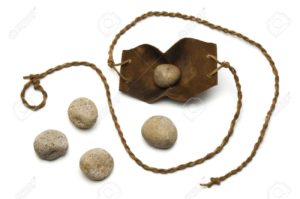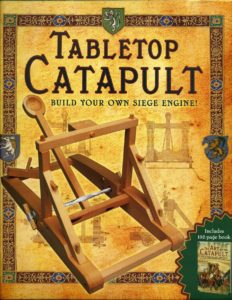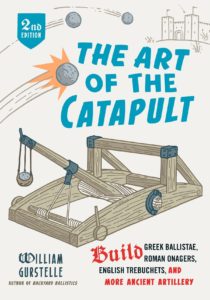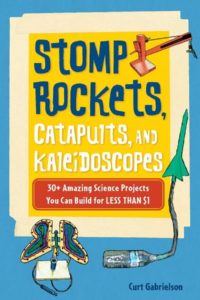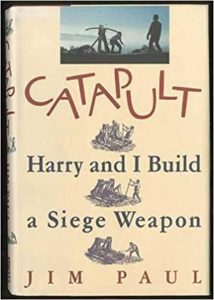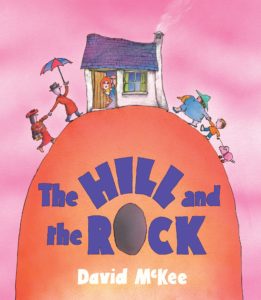
|
In David McKee’s The Hill and the Rock (Andersen Press, 2011), Mr. and Mrs. Quest live on top of a hill with a wonderful view – except from the kitchen window, which is blocked by an enormous rock. Finally, frustrated, they roll the rock down the hill – with the result that the hill deflates like a balloon, goes flat, and then sinks to form a valley, leaving the Quests at the bottom of a hole. Luckily the rock rolls back down the slope and settles in front of the kitchen window again, the hill inflates, and all is restored to normal. For ages 3-6. |
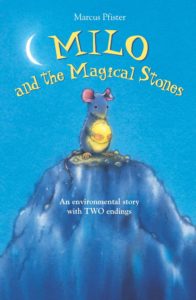
|
In Marcus Pfister’s, Milo and the Magical Stones (NorthSouth, 2010), Milo, a little mouse who lives in a cold cave on an island, finds a magical glowing stone that provides both light and heat. All the other (cold) mice promptly want stones of their own – though Balthazar, a particularly wise mouse, warns that if something is taken away from the island, something must be returned. The book then splits in two: there’s both a happy ending and a sad ending, depending. Basically, it’s a morality tale about environmental responsibility. For ages 3-7. |
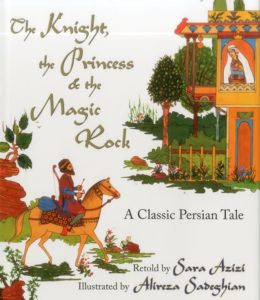
|
By Sara Azizi, The Knight, the Princess, and the Magic Rock (Wisdom Tales, 2012) is a picture-book re-telling of the traditional Persian tale about Bijan, a brave knight, who falls in love with Manijeh, princess of an enemy kingdom, and ends up imprisoned in a pit covered by a magic rock. For ages 4-8. |
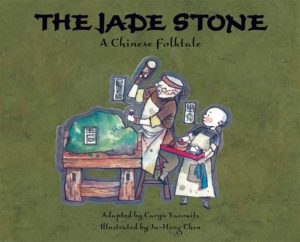
|
In Caryn Yacowitz’s The Jade Stone (Pelican Publishing, 2005), a retelling of a traditional tale, the Great Emperor of China gives a stone carver a perfect piece of green-and-white jade and demands that it be made into a dragon – but the carver, a true artist, knows that this is not what the stone wants to be. For ages 4-8. |
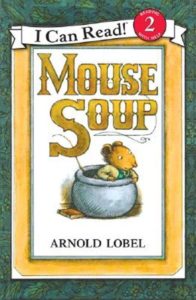
|
In Arnold Lobel’s Mouse Soup (HarperCollins, 2011), a dimwitted weasel catches a mouse with the intention of turning him into soup. Luckily the mouse turns the tables by means of four stories, among them the tale of “Two Large Stones.” Delightful for ages 4-8. |
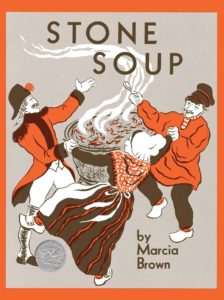
|
In Marcia Brown’s Caldecott-winning Stone Soup (Aladdin, 1997), originally published in 1947, three soldiers trudging home from the war come to a little French village, where the peasants rush to hide their food – until the clever soldiers begin to prepare a batch of Stone Soup. Soon everyone comes forward to offer ingredients, and in no time there’s a wonderful feast and a town party. For ages 4-8. |
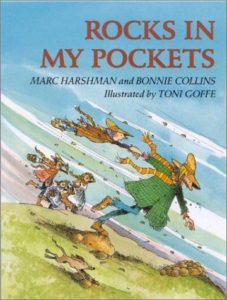
|
By Marc Harshman and Bonnie Collins, Rocks in My Pockets (Quarrier Press, 2002) is the story of the Woods family who live on a high mountain where the winds are so wild that they must carry rocks in their pockets to keep from being blown away. They also play games with the rocks, tell stories with rocks, and heat their beds with rocks. Then visitors from the city admire the Woods’s rocks and buy some to take home – which starts a positive run on rocks. For ages 4-9. |
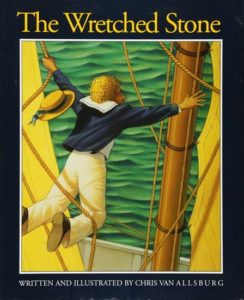
|
In Chris Van Allsburg’s The Wretched Stone (Houghton Mifflin, 1991), told through a ship captain’s log, the crew has brought on board a mysterious glowing stone found on a desert island. They become obsessed with the stone, which has terrible effects; soon all have been transformed into apes. They’re saved by a near-shipwreck that sends the stone to the bottom of the sea. An object lesson about the perils of too much TV for ages 5-9. |
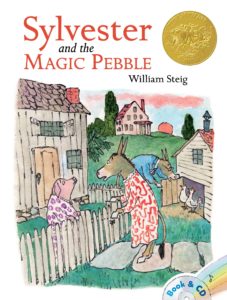
|
In William Steig’s Sylvester and the Magic Pebble (Aladdin, 2006), Sylvester, a young donkey, collects pebbles “of unusual shape and color.” One rainy Saturday he finds a magic pebble, capable of granting wishes – but on the way home to tell his parents the news, he encounters a lion, panics, and saves himself by wishing to be turned into a rock. The problem: he’s dropped the pebble and can’t wish himself back again. For ages 5-8. |
| |
The Center for Philosophy for Children has guidelines and discussion questions to accompany Sylvester and the Magic Pebble. |
| |
For more resources, see Philosophy. |
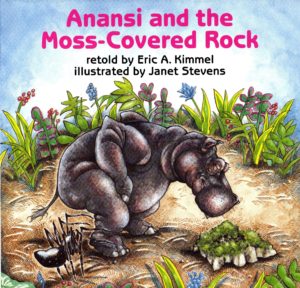
|
Eric Kimmel’s Anansi and the Moss-Covered Rock (Holiday House, 1990) is a West African folktale featuring Anansi, the trickster spider, who finds a moss-covered rock that magically puts animals to sleep. He comes up with a nefarious scheme in which he leads animals to the rock, puts them to sleep, and then steals their stores of food – until shy little Bush Deer puts a spoke in his wheel. For ages 5-8. |
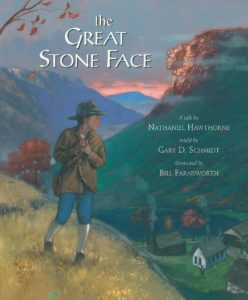
|
Gary Schmidt’s 32-page The Great Stone Face (Eerdman’s Books for Young Readers, 2005) is a re-telling of the classic Nathaniel Hawthorne tale in which a prophecy holds that someone will be born who looks just like New Hampshire’s Great Stone Face – the rock formation commonly called the Old Man of the Mountains – and he will be “the noblest person of his time.” For ages 7-11. |
| |
Read Nathaniel Hawthorne’s The Great Stone Face online here. |
| |
The Great Stone Face – a.k.a. the Old Man of the Mountains – is no more; once a series of granite ledges on Cannon Mountain in New Hampshire’s White Mountains, the Great Stone Face broke away and fell in 2003. Read about its history here. |
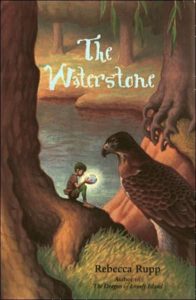
|
Rebecca Rupp’s The Waterstone (Candlewick, 2005) features a quartet of tiny characters – Tad and Birdie of the Fisher Tribe, Ditany of the Hunters, and Will of the Diggers – who are on a quest to regain the fabled Waterstone from a powerful and evil nixie who is withholding the world’s water. This one got a STARRED REVIEW from Kirkus! For ages 9-12. |
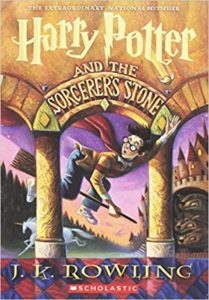
|
Is there anyone in the world who hasn’t read Harry Potter? In Book One of J.K. Rowling’s ubiquitous series, Harry Potter and the Sorcerer’s Stone (or, in England, Philosopher’s Stone) (Scholastic, 1999), Harry and his Hogwarts pals attempt to prevent the evil Lord Voldemort from stealing the fabled sorcerer’s stone. For ages 9 and up. |
| |
Read about The Philosopher’s Stone – in alchemy a substance supposedly capable of turning base metals into gold. |
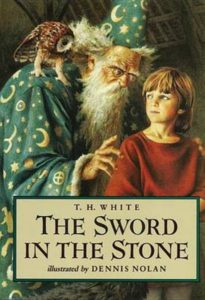
|
T.H. White’s The Sword in the Stone (Philomel, 1993) is the first part of his much longer King Arthur saga, The Once and Future King. This is a stand-alone family read, the story of Sir Ector’s ward, young Wart, and his astonishing education by the old wizard, Merlin, culminating with his pulling the sword from the stone and revealing himself as King Arthur. Wonderful for ages 9 and up. |
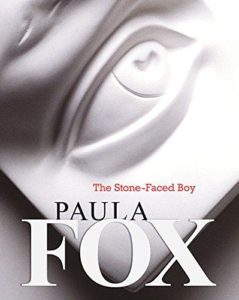
|
Paula Fox’s The Stone-Faced Boy (Front Street, 2005) is the story of Gus, middle child in a large and noisy family, who hides his emotions behind an expressionless face. The only person who understands seems to be his great-aunt Hattie – who gives him a geode, a rock filled with beautiful crystals inside. For ages 9-12. |
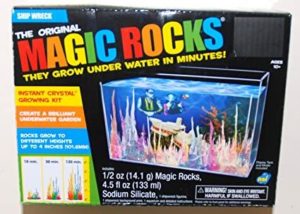 |
Grow Magic Rocks! Kits come with a tank, ingredients, instructions, and (depending on the version) a figurine of a shipwreck, shark, pirate treasure chest, or octopus. Rapidly grows a forest of dramatic crystals. Recommended for ages 10 and up without supervision; all ages with. Kits cost about $10. |
| |
Make Your Own Magic Rocks explains how to make your own chemical crystal garden. |
| |
From Science Buddies, see Guide to Purchasing Chemicals, which has explanations, a common-names list, and suppliers. |
